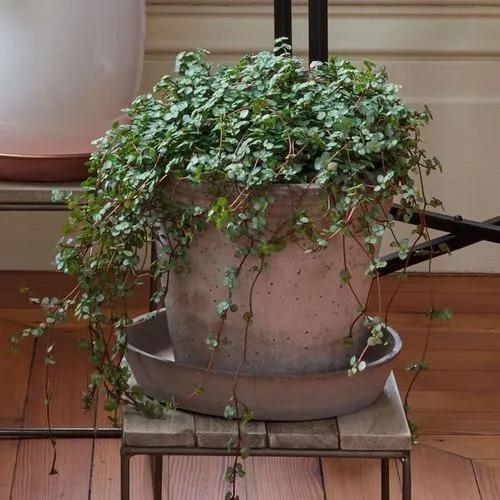Maidenhair Vine is a very adaptable plant that can be the star both indoors and outdoors. Its evergreen curly vines will trail around small spaces in the garden, directly in the soil or a container, or grow as decorative plants inside your home. It is also a great shader for other plant companions, as the vines will shortly form a green, protective curtain from above.
Maidenhair Vine Care
Muehlenbeckia complexa



Meuhlenbeckia is a plant that can be found in many regions of the world, from Australia to North and South America, but its origins are from New Zealand, where it also got its Latin name, Muehlenbeckia complexa, for the “complexity” formed by its vines when they grow untamed in their natural habitat. They reach maturity at around 6 years, and they can spread up to 8.2 ft (2,5 m) in diameter and grow 6-8 inches (15-20 cm) tall. The plant is grown for its rich foliage that can cover dull spaces or put indoors on a green spot. It can also be found by the name of “mattress plant” due to its capacity to cover up flat space just like a mattress would, but it is also named wiggy-bush or wire vine.
How to Care for the Plant

Water

Water it regularly, letting the top third of the soil dry in between watering. Finding the perfect amount for it can get a little tricky at times, but as Maidenhair Vine is a forgiving plant, you can afford some trials and errors before you figure out the perfect amount combined with sunlight and temperature. Overwatering can cause root rot, while underwatering will show its signs by yellowed leaves or brown burnt-like spots on the leaves. No growth can result from both, so keep a consistent schedule when watering this plant.

Pruning

Prune any dying or yellowed leaves or parts to ensure good airflow and prevent pests. Prune its vines to maintain their desired shape, but never cut in yellow parts as this can spread the damage to the plant.

Fertilizer

Maidenhair Vine needs fertilizer every four watering sessions during the warm season and every six waterings during colder months. Use a normal houseplant fertilizer instead of an all-purpose one to ensure that its foliage thrives and gets all the nutrients it needs.

Sunlight

Muehlenbeckia enjoys as much bright light as possible, but try to keep it away from direct sunlight, as this can burn the leaves of the plant. If your spots by the window are already occupied, and the plant cannot get enough light, consider buying extra full-spectrum light to support its growth.

Soil

Muehlenbeckia likes moist soil, but beware that it can develop mold if the plant gets too little light. The soil type for this plant varies from loamy, clay soil to sandy soil. As long as you ensure good drainage to it, the plant should do just fine.

Propagation

The most suitable word to use when it comes to Maidenhair Vine propagation is patience. The propagation process takes up to five months and requires lots of care, but clean scissors and compost can help you succeed. Propagation is most efficiently done through stem cutting. Cut a healthy part of the plant that is somewhat easy to bend but not too young. Make sure the cutting has two nodes: one will form the leaves, and the other will grow its roots. Cut below the node and place one of the nodes in compost with the leaf part out of the soil. Keep it away from direct sun, but let it be in direct sunlight through the growth period. Wrap the plant in a plastic bag, and you will know the new plant is formed once you see the second leaf appear.

Temperature

The best temperature conditions for this vine plant will be at 60-80°F (16- 27°C), but it can also resist negative temperatures. Avoid giving it temperature shocks. If you put it in a cold environment, gradually transition to a warmer one. Avoid keeping it outside if the temperature gets very high during summer, as this can reduce moisture and turn the leaves brown.

Container

As long as the container has drainage holes to avoid root rot from overwatering, you are good to go with any container. They can grow in deep containers, little baskets, or just anything that can be a recipient. You can give up the pot completely if you have a garden, as this plant will also thrive in soil, crawling or trailing in every space you allocate.

Fun fact

This one is a little drama queen and for good reasons. Too little care, and it will immediately start to turn its leaves into a deep shade of green, almost black. Once you give it the slightest attention, especially water, it will give you the brightest green without hesitation.

Popularity

4,482 people already have this plant 750 people have added this plant to their wishlists

Common pests

This plant is prone to attracting pests of all kinds, so keep an eye on it. Mealybugs, aphids, spider mites, whitefly, blackfly, root mealybugs, and vine weevils can all find a home in your Maidenhair Vine, mostly under its leaves or in the soil. A good wash and a suitable insecticide will help you get rid of these pests. Cut any affected parts and change the soil if needed, as this will strengthen the plant and make good use of its nutrients.

Frequent diseases


Botanist’s tips

Discover more plants with the list below
Popular articles






